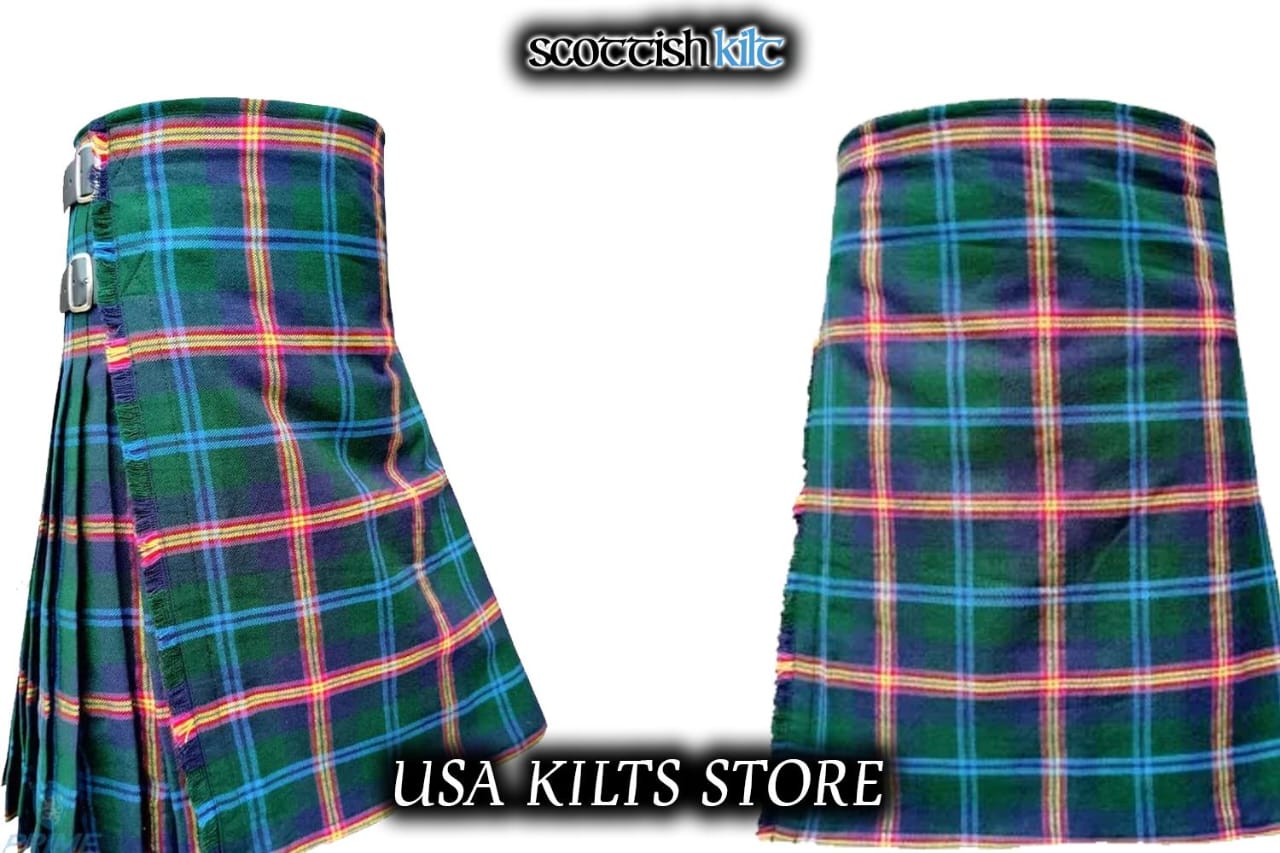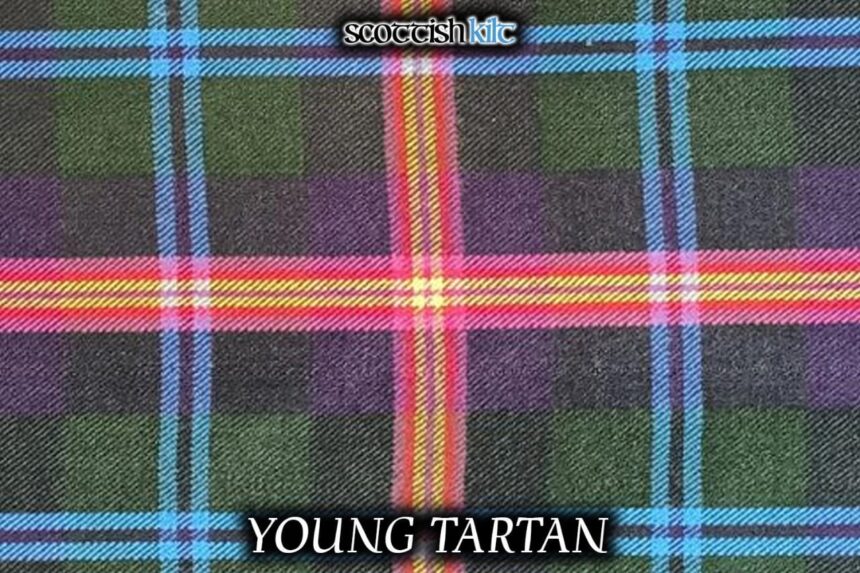The Clan Young Tartan, a distinguished pattern steeped in Scottish tradition, continues to captivate and inspire in the modern era. Originating from the rich tapestry of Scottish clan culture, this tartan embodies not only the heritage of the Young clan but also the evolving trends of contemporary fashion. Today, the Clan Young Tartan finds its place in various facets of modern life, from traditional Scottish attire to stylish accessories and home decor. Its presence in Scottish kilt shops highlights its enduring appeal, bridging the gap between historical significance and current fashion. This introduction to the Clan Young Tartan explores its transformation from a symbol of clan identity to a versatile and fashionable design element, illustrating how it remains a vibrant expression of Scottish pride.
What is the Clan Young Tartan?
The Clan Young Tartan is a unique pattern associated with the Young clan, a historic Scottish family. Its design is distinguished by specific color arrangements and stripe patterns that are emblematic of the clan’s identity. Typically, the tartan features a mix of bold and subdued colors, including shades of green, blue, and black, arranged in a symmetrical pattern of checks and stripes. Each color and line within the tartan holds significance, reflecting the clan’s heritage and the values they uphold. Historically, tartans were used not only for identification but also as a form of communication among clans. The Clan Young Tartan, like many others, was created to represent the clan’s lineage and regional associations. The design has evolved over centuries, incorporating elements that reflect both the clan’s historical development and the changing aesthetic preferences of the times. Understanding the Clan Young Tartan involves examining how its pattern was initially developed and how it has been maintained or modified through generations. In addition to its historical significance, the tartan also serves as a visual marker of clan affiliation. The use of tartans was historically regulated by Scottish law, with specific patterns assigned to different clans and regions. The Clan Young Tartan’s pattern reflects not only the family’s identity but also its status and role within the larger context of Scottish society. This distinctiveness has helped the tartan to remain a significant symbol of the Young clan, even as Scottish society has evolved.
Historical Origins of the Clan Young Tartan
The origins of the Clan Young Tartan are deeply rooted in Scotland’s medieval past. The Young clan, originally known as the ‘Yong’ or ‘Young,’ emerged during a period when clan culture was flourishing in the Scottish Highlands. Historical records suggest that the clan was established in the 13th century, with its members playing significant roles in various regional conflicts and alliances. The development of the Clan Young Tartan is closely tied to the clan’s historical journey and the socio-political landscape of the time. The tartan pattern itself likely evolved from earlier forms of textile design used by Scottish Highlanders. Initially, tartans were woven from wool and dyed with natural colors derived from local plants and minerals. The Clan Young Tartan would have been created using traditional weaving techniques, which were passed down through generations. Over time, the pattern would have become more refined and recognizable, incorporating specific colors and designs that distinguished it from other clan tartans. The historical significance of the Clan Young Tartan is also reflected in its association with key historical events. Members of the Young clan were involved in various military and political activities, and their tartan became a symbol of their loyalty and heritage. The tartan’s design may have been influenced by the clan’s interactions with other clans and their participation in broader historical events. Understanding the tartan’s origins provides insight into the clan’s history and the broader context of Scottish tartan tradition.
The Significance of Clan Tartan Patterns
Tartan patterns are more than just decorative designs; they carry deep cultural and historical significance. Each tartan pattern, including the Clan Young Tartan, is imbued with meanings that go beyond its visual appeal. The colors and stripes in a tartan often symbolize various aspects of the clan’s history, values, and connections to specific regions. In the case of the Clan Young Tartan, the pattern’s colors may reflect the natural environment of the clan’s historical territory. For instance, greens and blues might symbolize the landscapes of the Scottish Highlands, while darker colors could represent the clan’s strength and resilience. The arrangement of stripes and checks in the tartan can also convey messages about the clan’s social structure and historical alliances. Tartans played a crucial role in maintaining clan identity and cohesion. During times of conflict or clan gatherings, the tartan served as a visual representation of the clan’s unity and pride. The Clan Young Tartan, with its unique pattern, would have been worn to signify allegiance and to distinguish clan members from those of other clans. Understanding the significance of tartan patterns involves exploring how these designs were used to convey messages and maintain cultural traditions.
Regional Connections: Where Does the Clan Young Tartan Fit?
The Clan Young Tartan is intricately linked to several Scottish districts, each of which has contributed to the tartan’s design and significance. The regions associated with the Young clan include areas in the Scottish Highlands where the clan was historically active. These regional connections are reflected in the tartan’s colors and patterns, which often mirror the characteristics of the local landscapes and communities. The geographical area where the Young clan resided played a significant role in shaping the tartan’s design. For instance, the tartan’s colors might be inspired by the natural environment of the clan’s territory, such as the green of the forests or the blue of the lochs. Additionally, the pattern’s arrangement could reflect the clan’s relationship with neighboring clans and its position within the broader Scottish context. Examining the regional connections of the Clan Young Tartan provides insight into how tartans are not only markers of clan identity but also symbols of regional heritage. By understanding where the Young clan was based and how these areas influenced the tartan’s design, one gains a deeper appreciation of the tartan’s role in Scottish history and culture.
How Does the Clan Young Tartan Reflect Its Districts?
The design of the Clan Young Tartan is more than a mere aesthetic choice; it is a reflection of the clan’s historical and geographical context. The tartan’s colors and patterns are often closely aligned with the characteristics of the districts where the clan was active. This section explores how the tartan’s design elements relate to the regions associated with the Young clan. The colors used in the Clan Young Tartan may be symbolic of the natural features of the clan’s territory. For example, shades of green might represent the lush landscapes of the Scottish Highlands, while blues could signify the presence of water sources like rivers and lochs. The tartan’s pattern, including its checks and stripes, may also be influenced by the clan’s interactions with other clans and its role within the regional socio-political structure. By analyzing the tartan’s design in relation to its district connections, one can gain a deeper understanding of how tartan patterns serve as symbols of both clan identity and regional heritage. The Clan Young Tartan’s reflection of its districts underscores the interconnectedness of Scottish tartan tradition and the broader cultural landscape.
Clan Young Tartan and Its Role in Scottish Identity
The Clan Young Tartan plays a significant role in preserving and expressing Scottish identity. As a symbol of the Young clan’s heritage, the tartan contributes to the broader cultural landscape of Scotland. This section explores how the tartan functions as a marker of clan pride and its importance in contemporary Scottish society. In historical contexts, tartans like the Clan Young Tartan were used to signify clan allegiance and unity. The tartan served as a visual representation of the clan’s identity, helping members to distinguish themselves from other clans. This role remains significant today, as the tartan continues to be a symbol of heritage and pride for those connected to the Young clan. Modern uses of the Clan Young Tartan extend beyond traditional contexts. The tartan is worn at various Scottish events, including Highland Games, weddings, and cultural festivals. It also features in contemporary fashion and home decor, reflecting a blend of tradition and modernity. Understanding the tartan’s role in Scottish identity involves recognizing its continued relevance in both historical and contemporary contexts.
Modern Uses of the Clan Young Tartan – Where Can You Find It?
The Clan Young Tartan has found a prominent place in modern fashion and lifestyle, particularly through Scottish kilt shops. These specialty stores offer a diverse range of products that incorporate this historic tartan, making it accessible for both formal and casual wear. Scottish kilt shops are renowned for their extensive collection of traditional Scottish attire, including kilts, kilt jackets, and sporrans, all available in the Clan Young Tartan. This iconic garment, emblematic of Scottish heritage, is often custom-made to fit individual preferences, allowing for personal expression while honoring clan traditions. Beyond kilts, these shops also provide a variety of accessories, such as tartan scarves, ties, and waistcoats, that feature the Clan Young Tartan. These items are perfect for incorporating a touch of Scottish heritage into everyday outfits or for special occasions like weddings and clan gatherings. Additionally, Scottish kilt shops frequently offer bespoke options, enabling customers to create custom tartan products that align with their personal style. For those looking to display their clan pride at home, these shops may also carry tartan-themed home decor items, such as blankets and cushions. Many Scottish kilt shops have expanded their reach online, making it easier for people worldwide to access Clan Young Tartan products from the comfort of their homes.
How Can You Incorporate the Clan Young Tartan into Your Wardrobe?
For those interested in wearing the Clan Young Tartan, there are various ways to incorporate it into your wardrobe. This section provides practical advice on how to showcase the tartan with style and respect, whether for formal events or casual occasions. One popular way to wear the Clan Young Tartan is through traditional Scottish attire, such as kilts and sporrans. These garments are often worn at formal events and are a classic way to display the tartan. Additionally, tartan scarves, ties, and waistcoats are versatile options that can be incorporated into everyday outfits. When incorporating the tartan into your wardrobe, it is important to consider the occasion and the context in which you will be wearing it. For formal events, choose items that highlight the tartan’s traditional design, while for casual wear, opt for accessories that offer a more subtle nod to Scottish heritage. Understanding how to wear the Clan Young Tartan appropriately ensures that you honor its significance while showcasing your personal style.

Discover the Clan Young Tartan at a USA Kilts Store
For those seeking to embrace the Clan Young Tartan in the United States, the USA kilts store offers an exceptional selection of tartan products. Renowned for their commitment to quality and tradition, these stores provide a range of items featuring the Clan Young Tartan, including bespoke kilts, elegant accessories, and stylish home decor. With options for both custom orders and ready-made garments, the USA kilts store makes it easy to incorporate Scottish heritage into modern wardrobes and lifestyles. Their online platforms and physical locations ensure that enthusiasts across the country can access the timeless beauty of the Clan Young Tartan, blending tradition with contemporary fashion seamlessly.
Key Figures and Events Associated with the Clan Young Tartan
The Clan Young Tartan is associated with several notable figures and historical events that have shaped its history and significance. This section highlights key individuals and moments that have influenced the tartan’s legacy. Historical figures associated with the Clan Young Tartan include prominent members of the Young clan who played significant roles in Scottish history. These individuals may have been involved in military conflicts, political events, or social changes that impacted the clan’s status and the tartan’s design. Significant events related to the Clan Young Tartan include battles, treaties, and clan gatherings where the tartan was prominently displayed. These moments provide insight into the tartan’s historical context and its role in shaping the clan’s identity. By examining these key figures and events, one gains a deeper appreciation for the tartan’s place in Scottish history.
What Does the Future Hold for the Clan Young Tartan?
The future of the Clan Young Tartan involves a blend of tradition and innovation. As Scottish culture continues to evolve, the tartan’s role and significance may adapt to reflect contemporary trends and values. This section explores how the tartan is being preserved and adapted for future generations. Preserving the Clan Young Tartan involves maintaining its traditional design while also embracing modern interpretations. Efforts to ensure the tartan’s continued relevance include incorporating it into contemporary fashion, promoting its use at cultural events, and educating new generations about its history and significance. Looking ahead, the Clan Young Tartan may continue to evolve as Scottish fashion and cultural practices change. By blending tradition with innovation, the tartan can remain a meaningful symbol of heritage while also resonating with modern audiences. Understanding the future of the Clan Young Tartan provides insight into how cultural traditions can adapt while preserving their core values.
Conclusion
The Clan Young Tartan is a rich symbol of Scottish heritage, connecting past and present through its unique design and historical significance. By exploring its origins, regional connections, and modern uses, we gain a deeper appreciation for its role in Scottish culture. Whether worn in traditional attire or incorporated into contemporary fashion, the Clan Young Tartan remains a vibrant expression of clan identity and Scottish pride.
Also Read: Alayllinnn_: Pioneering Digital Influence & Sustainable Style






